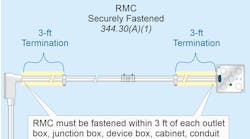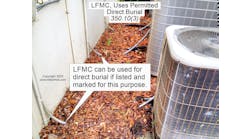All questions and answers are based on the 2008 NEC.
Q. What is the sizing rule for an equipment grounding conductor in a raceway that contains multiple circuits?
A. When multiple circuits are installed in the same raceway, cable, or cable tray, only one equipment grounding conductor is required for the multiple circuits, sized in accordance with 250.122, based on the rating of the largest circuit overcurrent device [250.122(C)]. Single conductors used as equipment grounding conductors in cable trays must be sized 4 AWG or larger [392.3(B)(1)(c)], as shown in the Figure.
Q. What are the GFCI requirements for non-dwelling units?
A. GFCI protection is required for all 15A and 20A, 125V receptacles installed in the following commercial/industrial locations [210.8(B)]:
(1) Bathrooms. See the definition of “Bathroom” in Art. 100.
A 15A or 20A, 125V receptacle isn’t required in a commercial or industrial bathroom, but if one is installed, it must be GFCI-protected.
(2) Kitchens.
All 15A and 20A, 125V receptacles installed in an area with a sink and permanent facilities for food preparation and cooking [Art. 100], even those that don’t supply the countertop surface, must be GFCI-protected. GFCI protection is not required for receptacles rated other than 15A and 20A, 125V in these locations. GFCI protection is not required for hard-wired equipment in these locations.
(3) Rooftops.
A 15A or 20A, 125V receptacle outlet must be installed within 25 ft of heating, air-conditioning, and refrigeration equipment [210.63].
(4) Outdoors.
(5) Sinks.
All 15A and 20A, 125V receptacles installed within 6 ft of the outside edge of a sink must be GFCI-protected.
There is an exception noted for items (3) and (4) above: GFCI protection isn’t required for a fixed electric snow-melting or deicing equipment receptacle supplied by a dedicated branch circuit, if the receptacle isn’t readily accessible — and the equipment or receptacle has ground-fault protection of equipment (GFPE) [426.28].
Q. What is the maximum number of bends in a circular raceway?
A. This answer is found in each individual raceway Article of the Code. Basically, the maximum number of degrees between pull points is limited to 360° for non-flexible circular raceways. For example, 344.26 deals with rigid metal conduit and says: “To reduce the stress and friction on conductor insulation, the maximum number of bends (including offsets) between pull points cannot exceed 360°.”
The same rule exists for other circular raceways and is located in the following sections of the NEC: 342.22, 348.26, 352.26, 353.26, 354.26, 355.26, 358.26, and 362.26.
Note: There is no maximum distance between pull boxes because this is a design issue, not a safety issue.
Q. What are the GFCI protection requirements for swimming pool pump motors?
A. Outlets supplying pool pump motors for a permanently installed pool, outdoor spa, or outdoor hot tub from branch circuits rated 15A or 20A, 120V or 240V must be GFCI-protected [680.22(B)].




